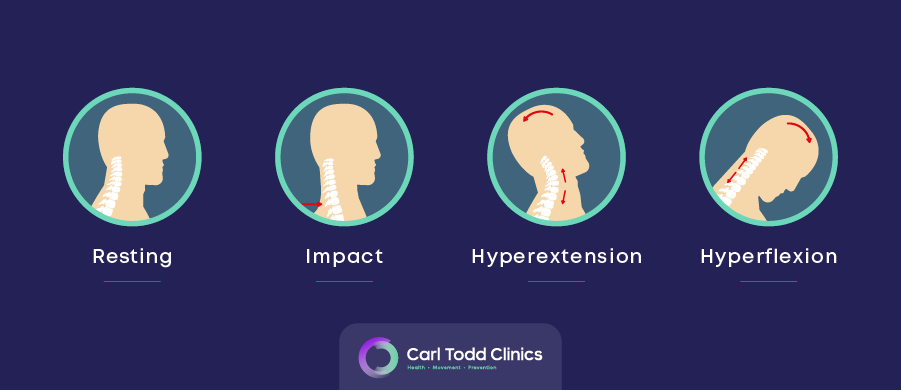Whiplash injuries can be debilitating, often causing persistent pain and restricted movement. These injuries commonly occur due to sudden acceleration-deceleration forces, frequently experienced in car accidents or during contact sports. While they are often associated with neck discomfort, whiplash can affect various parts of the body, including the lower back.
In this article, we’ll explore the nature of whiplash injuries, their symptoms, and how osteopathy can aid in their treatment, particularly in restoring neck mobility.
What is a whiplash injury?
A whiplash injury typically occurs when the body undergoes a sudden and forceful movement, often resembling the cracking of a whip. This motion can strain the muscles and ligaments in the neck and surrounding areas. However, it’s important to note that whiplash injuries aren’t limited to just the neck; they can also affect the lower back.
The abrupt and intense motion involved in whiplash can lead to various symptoms and complications, necessitating appropriate treatment.

What are the symptoms of whiplash?
Symptoms of whiplash can vary widely from person to person and depend on the severity of the injury. Common symptoms include neck pain, stiffness, and reduced range of motion. Additionally, individuals may experience headaches, dizziness, and fatigue. In some cases, whiplash can also cause more serious symptoms, such as:
- Numbness or tingling in the arms or hands
- Weakness in the arms or legs
- Loss of balance or coordination
- Difficulty swallowing
Interestingly, lower back whiplash symptoms are also very common, with many sufferers reporting discomfort and limited mobility in the lumbar region. Recognising these symptoms is crucial for early diagnosis and effective management of the condition.
How does whiplash affect the body?
Whiplash injuries can have far-reaching effects on the body, beyond just the neck. The sudden jerking motion can cause soft tissue damage, leading to inflammation and pain. The impact of whiplash can disrupt the spine’s alignment, potentially causing issues such as misalignments or subluxations. Here’s a breakdown of how it happens:
- Forceful movement: The sudden back-and-forth motion of the head stretches and tears these tissues in the neck beyond their normal range.
- Inflammation: The body responds to the injury by sending inflammatory cells to the area. This inflammation can cause pain, swelling, and stiffness.
- Muscle spasms: The muscles in the neck can go into spasm in an attempt to stabilise the injured area. These spasms can be very painful and make it difficult to move the head.
- Nerve irritation: In some cases, the inflammation can also irritate the nerves in the neck. This can cause pain, numbness, and tingling in the neck, shoulders, and arms.
The severity of these symptoms depends on the incident that caused the whiplash. In most cases, the body can heal itself over time. However, some people may experience chronic pain, headaches, and difficulty moving their neck even after treatment.
In the case of lower back whiplash symptoms, the lumbar spine and surrounding muscles may bear the brunt of the injury, resulting in discomfort and restricted movement. Left untreated, whiplash can lead to chronic pain and decreased quality of life.
How can osteopathy help with whiplash symptoms?
Osteopathy offers a holistic approach to treating whiplash injuries, focusing on restoring balance and mobility to the affected areas. Osteopaths are trained to assess the body as a whole, identifying areas of tension, restriction, and dysfunction.
Through gentle manipulation techniques, osteopathic practitioners aim to realign the spine, release muscle tension, and improve circulation, promoting the body’s natural healing process. In the context of whiplash injuries, osteopathy can target not only the neck but also the lower back, addressing symptoms comprehensively for optimal recovery.
Pain Reduction and Improved Mobility
Osteopathic treatment often involves gentle manipulation and mobilisation of joints and muscles in the neck and surrounding areas. This can help to reduce pain, inflammation, and stiffness, ultimately improving your range of motion.
Addressing Soft Tissue Issues
Techniques like myofascial release aim to ease tension in the soft tissues (ligaments, tendons, muscles) that can be strained or tight due to whiplash.
Promoting Rehabilitation
Osteopaths often incorporate rehabilitation exercises into the treatment plan. These exercises can focus on stretching, strengthening the neck muscles, and retraining proprioception (your body’s awareness of its position in space). This helps improve stability and prevent future problems.
Whiplash Injury Treatment
Osteopathic treatment for whiplash injuries typically involves a combination of hands-on techniques, exercise prescription, and lifestyle recommendations. Manual therapy techniques, such as soft tissue manipulation and joint mobilisation, can help alleviate pain and restore mobility in the affected areas. Here’s how osteopathic treatment can help with whiplash:
- Manual therapy: Osteopathic manual therapists use a variety of techniques, such as massage, stretching, and joint mobilisation, to improve range of motion in the neck and spine.
- Myofascial release: This technique involves applying gentle pressure to tight muscles and fascia (the connective tissue that surrounds muscles) to help release tension and improve flexibility.
- Cranial osteopathy: This is a gentle form of osteopathy that focuses on the bones of the head and sacrum (the triangular bone at the base of the spine). It is thought to improve circulation and nerve function.
Additionally, osteopaths may recommend specific exercises to strengthen the neck and back muscles, improving stability and reducing the risk of future injuries. Lifestyle modifications, including ergonomic adjustments and stress management techniques, may also be incorporated to support long-term recovery. It’s essential to work closely with a qualified osteopath to develop a personalised treatment plan tailored to your unique needs and circumstances.
In conclusion, whiplash injuries can have significant implications for neck mobility and overall well-being. However, osteopathy offers a safe and effective approach to managing whiplash symptoms and restoring function. By addressing the underlying causes of pain and dysfunction, osteopathic treatment can help individuals recover from whiplash injuries more quickly and completely.
If you’re experiencing symptoms of whiplash, including lower back discomfort, don’t hesitate to reach out to our qualified osteopaths. With their expertise and personalised care, you can regain mobility and get back to enjoying life to the fullest.





